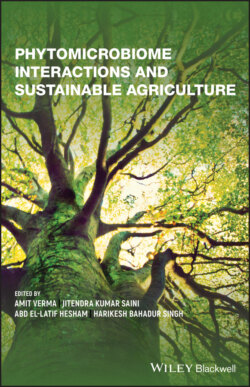Читать книгу Phytomicrobiome Interactions and Sustainable Agriculture - Группа авторов - Страница 21
2.1 Introduction
ОглавлениеThe ecosystem thrives with the dynamism of interactions between abiotic and biotic aspects of life. The ecosystem harbors a wide diversity of species ranging from a plethora of microorganisms to macroorganisms. Every living being is predisposed to an assortment of nutritional as well as environmental requirements. These needs, when catered to by the ecosystem, make the living conducive. The most astounding feature of the ecosystem is that every living being is genetically distinct with unique living requirements yet tend to coexist with communal harmony within the same environment. This harmony is met with a balanced equilibrium of benefit‐sharing among species for sustained and enhanced living.
Every organism is capable of managing its metabolic niches by first sequestering it through the resources available within the surrounding environment and subsequently subjecting it through metabolic processing for its use. The organisms can only survive in the ecosystem where there are enough resources for its utilization for their healthy living and growth. Nonetheless, at times for a particular metabolic requirement, the mutualistic benefit‐sharing occurs between different species when the organism of one species is unable to fulfill its nourishment requirements and depends upon the other. This establishes a harmonious exchange of growth and enhancement benefits without breaching the living integrity of another. However, not all the species contains a harmonious tendency and tries to breach the living system of another to attain a competitive edge in survival. This acts as a detriment to the survival of other species on the whole.
Nonetheless, most of the species reside within an ecosystem with an effort of communal harmony among one another to support each other to sustain and maintain a healthy ecosystem. Hence an ecosystem comprises a consortium of species at the multitudes of genetic diversity existing with each other through a beautiful exchange of mutual benefits while preserving their interests.
Plant–microbe associations best exemplify such mutualistic associations in the ecosystem. The plants act as a meta‐organism harboring a consortium of microorganisms living in symbiosis with a variety of plant organ systems. Microbes may colonize the various parts of the plants, be it plant surfaces, areas adjoining the areas around the plant surface, or the interstitial spaces present between the adjoining cells. A phyto‐organ system apart from being the sheltered habitat and a future source of nutrition for the surrounding microbial population may attract the tiny creatures for their metabolic benefits by releasing such chemicals that stabilize the colonization of the beneficial microbial colonies. The growth of beneficial microbes, in turn, provides an increment in plant health. Moreover, the microbial signaling system is so developed that upon sensing some stress or threat, the microbial consortium confers changes in metabolism, thus rendering great adaptability and protection by releasing metabolites and antibiotic agents against pathogenic invasion.
Plants are of utmost importance from the view of the ecosystem as well as from the view of commercial viability. Plants form the framework of the ecosystem and provide nourishment and shelter to almost all living beings. Understanding the methods of the best sustenance of the plant within its natural system and providing further enhancement under stressed conditions become the foundation of studying mandatory growth parameters of plants. Since microbes work in close association of plants to enhance and enrich them, thus study of plant microbial associations are of great reputation to humankind as well as to the environment. Therefore, this chapter provides a crisp overview of the plant microbial associations and their manipulation through the proteomics approach, which shall further lead us to touch the proteomic perception of this association deciphered through technical knowhow.
